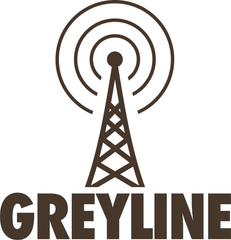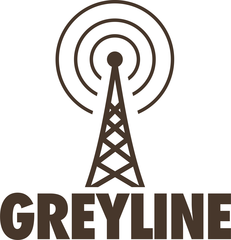
How to Choose the right Coax Cable
Summary:
Greyline promotes LMR-400 as the best performance for the money vs. lesser and/or highest quality coax owing to the fact most of us require less than 200' and more likely less than 100' runs to our antenna site, therefore, the equation of loss per-foot may be less pronounced. Even so, we desire a higher-quality component as "every dB counts!" If you desire the best for your install consider the more expensive Heliax coaxial cable (comparisons below) as an option. The professionals and most serious radio installations definitely consider Heliax.
A useful communique on the subject was recently discussed on a prominent ARC Amateur Radio Club website we thought was useful for you. We hope you find this quite useful as a confirmation on the topic of coax comparisons and a "how to choose coax."
There are many coaxial cable reference guides, performance charts, and other comparisons that are quite useful. We've heard legends who have built major radio stations in their lifetimes and we listen. Here's some wisdom we captured on the topic.
The best way to make technical decisions like this is by comparing practical alternative solutions rather than absolute performance metrics alone.
For example, when comparing coaxial cable alternatives, consider at least three practical alternatives. Then choose the best alternative.
Most Coax cable is compared at 100' lengths for loss and performance. At 25' this loss is of course 1/4th the stated losses, or for 200' lengths, 1/8th. In any case, every dB counts, so do choose wisely. Note: Likely, for most of us with shorter runs to the antenna site, anything below 20M is inconsequential for loss alone, but we will maintain using the best possible coax is considered smart to avoid unnecessary headaches.
--
An example of such a decision-making process, for 200 feet of coax on 10 meters:
RG-213 2.1 dB (baseline for comparing alternatives)
LMR-400 1.3 dB (0.8 dB improvement)
LDF4-50 0.7 dB (1.4 dB improvement at reasonable cost, wind & ice loading) - ice loading is needed when feedline is part of the towers wind and ice load
LDF5-40 0.4 dB (1.7 dB improvement at high cost, wind and ice loading)
LDF6-50 0.3 dB (1.8 dB improvement at high cost, wind and ice loading)
Clearly, LDF4-50 is the best choice when the additional cost, wind area, and ice loading of LDF5-50 and LDF6-50 are taken into consideration.
Similar tradeoff-based decision-making can be used for antennas and many other aspects of a ham station performance improvements.
LMR-400 is a very cost-effective choice for a 300-foot length of coax cable. The small additional cost of 300 feet of LMR-400 compared to RG-213 produces a worthwhile improvement on 15 meters and above, the improvement is relatively insignificant on 20 meters and below.
$700 in additional cost for LDF4-50A or similar 1/2" hardline including connectors produces only one dB of improvement on 10 and 6 meters compared to LMR-400, probably not worth the high cost unless you can obtain LDF4-50A for about one dollar per foot.
$2000 in additional cost for LDF5-50A or similar 7/8" hardline and connectors compared to the cost of LDF4-50A produces less than one dB of improvement compared to LDF4-50A on every HF band and 6 meters, not worth the high cost on any HF band or 6 meters.
Here's the data supporting my conclusions:
This is the loss in 300 feet of commonly used coax feeding an antenna with 1:1 VSWR
Coax 7 MHz 14 MHz 21 MHz 28 MHz 50 MHz
Loss Loss Loss Loss Loss
RG-213 1.5 dB 2.2 dB 3.0 dB 3.6 dB 4.8 dB
LMR-400 1.0 dB 1.4 dB 1.7 dB 1.9 dB 2.6 dB
LDF4-50 0.5 dB 0.7 dB 1.0 dB 0.9 dB 1.5 dB
LDF5-50 0.3 dB 0.4 dB 0.5 dB 0.6 dB 0.8 dB
Here's the same data, but comparing improvement for each coax type compared to RG-213, measured in dB:
Coax 7 MHz 14 MHz 21 MHz 28 MHz 50 MHz
LMR-400 0.5 dB 0.8 dB 1.3 dB 1.7 dB 2.2 dB
LDF4-50 1.0 dB 1.5 dB 2.0 dB 2.7 dB 3.3 dB
LDF5-50 1.2 dB 1.8 dB 2.5 dB 3.0 dB 4.0 dB
References:
W3LPL www.qrz.com/db/w3lpl
Universal Radio: Coaxial Cable Performance Charts: www.universal-radio.com/catalog/cable/coaxperf.html
WHAT CUSTOMERS ARE SAYING:
- "Real DX 160-6M at my HOA"
- "4 Band DXCC in 3-months at my HOA."
- "So pretty my XYL approves!"
- "If I can hear it, I can work it."
+ See customer install pics and Real DX stories
https://greylineperformance.com/pages/faq#reamaze#0#/kb/customer-reviews
+ The Benefits of Greyline Performance Antennas
https://greylineperformance.com/pages/faq#reamaze#0#/kb/technical-data/the-benefits-of-greyline-antennas-smart-rugged-elegant-antenna-design
Smarter, Stronger, and more Elegant than any other all band option!
Let's get you and your friends back on the air.
Ham Radio is fun again! Pass it on...

- LIST OF BENEFITS for Greyline Performance Antennas
- Common Questions from Ham Radio Customers
- 16' DX Flagpole Antenna and SGC-237 remote tuner works 160-6M (install pictures) at KJ7CWQ
- Beautiful Flagpole Antenna, regularly work DX (Africa, Europe, SA) with 60W on FT8 and CW at WJ8B
- "Happy XYL" in Pennsylvania: New Ham says "happy wife, quiet bands & loud signals! Going for my Extra."
- Do I really need a Tuner at the Base of my Greyline Flagpole Antenna and HF Vertical Antenna
- 28' HF Vertical Antenna in New Mexico reports "good reports about strong signals"
- 20' Flagpole Antenna, Bill in Florida one-calls XR0ZRC with 100W & runs the bands after 30-years off the air!
- 24' Flagpole Antenna: K7CWC Cliff in Washington (W7) is spotted around the World on his Greyline 24' DX Flagpole
- Greyline makes the Cover of CQ Magazine from Montenegro - September 2021
- Surf Ham Radio Waves with KL2A
